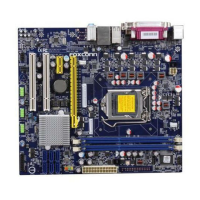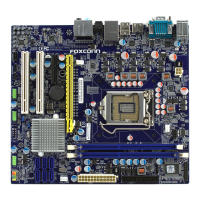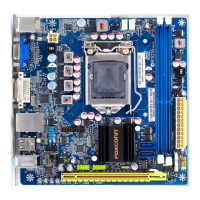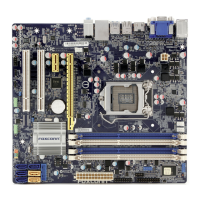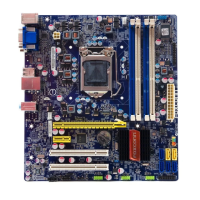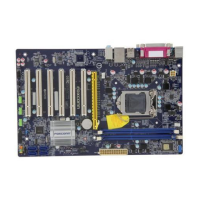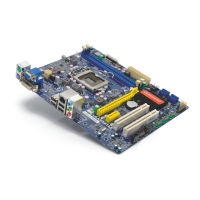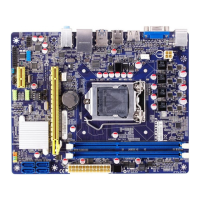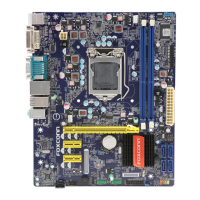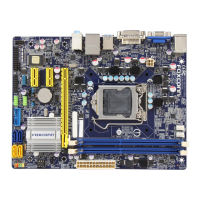Do you have a question about the Foxconn H55M-S and is the answer not in the manual?
Safety measures for electrostatic discharge and power handling during installation.
Warnings and advice for installing CPU, memory, expansion cards, and connectors.
Detailed specifications for CPU, memory, expansion slots, storage, LAN, and audio.
Visual guide to motherboard components, connectors, and headers with numerical labels.
Explanation of the function and usage of each port on the motherboard's rear panel.
Step-by-step guide for CPU installation, including thermal grease application and cooler mounting.
Instructions for installing DDR3 DIMMs and understanding dual-channel memory configurations.
Process for installing expansion cards like graphics cards into PCI Express slots.
Details on connecting power supply connectors, audio, USB, SATA, and other internal headers.
Explanation of jumper functions, including Clear CMOS and Intel ME jumper settings.
How to access the BIOS setup and navigate its main menu options.
Viewing system details (BIOS version, memory) and configuring advanced boot features.
Configuring advanced chipset features, integrated peripherals, and CPU settings like clock and voltage.
Settings for power saving, system security passwords, and loading default BIOS configurations.
Overview of drivers and software utilities available on the CD and their installation.
Using FOX ONE for system monitoring, fan control, CPU frequency, and voltage adjustments.
Utility for backing up, updating BIOS, drivers, and other system software via local or online methods.
Utilities for customizing the boot logo and viewing system management interface information.
Safety measures for electrostatic discharge and power handling during installation.
Warnings and advice for installing CPU, memory, expansion cards, and connectors.
Detailed specifications for CPU, memory, expansion slots, storage, LAN, and audio.
Visual guide to motherboard components, connectors, and headers with numerical labels.
Explanation of the function and usage of each port on the motherboard's rear panel.
Step-by-step guide for CPU installation, including thermal grease application and cooler mounting.
Instructions for installing DDR3 DIMMs and understanding dual-channel memory configurations.
Process for installing expansion cards like graphics cards into PCI Express slots.
Details on connecting power supply connectors, audio, USB, SATA, and other internal headers.
Explanation of jumper functions, including Clear CMOS and Intel ME jumper settings.
How to access the BIOS setup and navigate its main menu options.
Viewing system details (BIOS version, memory) and configuring advanced boot features.
Configuring advanced chipset features, integrated peripherals, and CPU settings like clock and voltage.
Settings for power saving, system security passwords, and loading default BIOS configurations.
Overview of drivers and software utilities available on the CD and their installation.
Using FOX ONE for system monitoring, fan control, CPU frequency, and voltage adjustments.
Utility for backing up, updating BIOS, drivers, and other system software via local or online methods.
Utilities for customizing the boot logo and viewing system management interface information.
| Number of memory slots | 4 |
|---|---|
| Maximum internal memory | 16 GB |
| Supported memory clock speeds | 800, 1066, 1333 MHz |
| Processor socket | LGA 1156 (Socket H) |
| USB 2.0 connectors | 2 |
| S/PDIF out connector | Yes |
| Number of SATA connectors | 6 |
| Number of Parallel ATA connectors | 0 |
| Serial ports quantity | 1 |
| USB 2.0 ports quantity | USB 2.0 ports have a data transmission speed of 480 Mbps, and are backwards compatible with USB 1.1 ports. You can connect all kinds of peripheral devices to them. |
| Power source type | ATX |
| Audio output channels | 7.1 channels |
| Motherboard form factor | micro ATX |
| Compatible operating systems | Win XP, Vista |
| Parallel processing technology support | Not supported |
| Networking features | 10/100/1000 Mbps |
| BIOS type | - |
| BIOS memory size | 64 Mbit |
| Manageability features | PCI 2.3, USB2.0, DMI 2.5 |
| Depth | 228 mm |
|---|---|
| Width | 244 mm |
